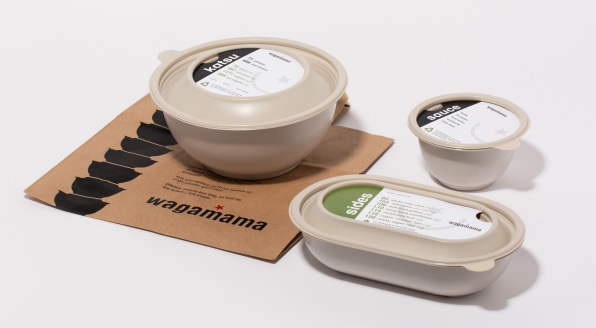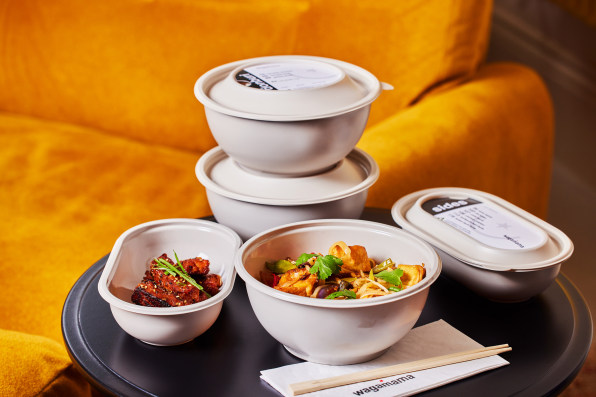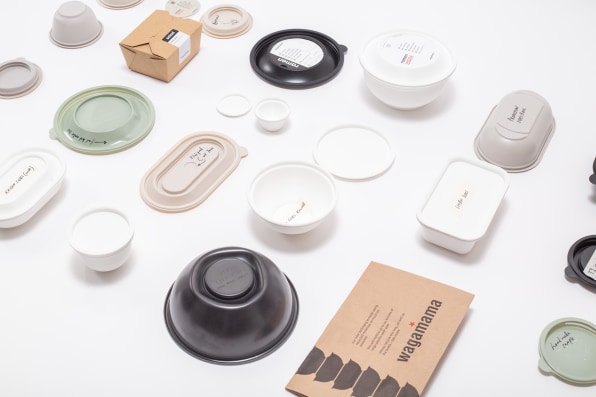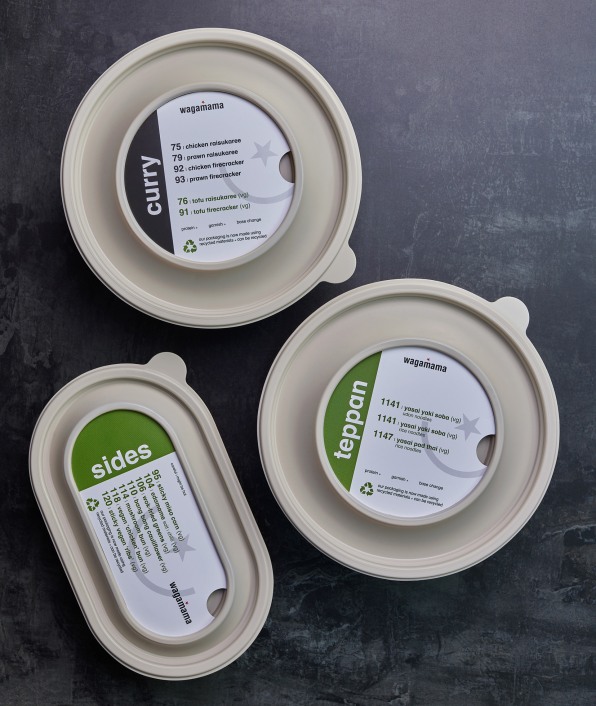
Take-out food is the best. You spend 5 minutes salivating over a mobile menu, then a feast you didn’t have to cook lands at your doorstep 30 minutes later.
Take-out food is also the worst. The food never tastes as good as it does in the restaurant by the time it’s made it into your hungry mouth. Then there’s all that single-use plastic.
In both cases, packaging is to blame.
In 2021, British restaurant chain Wagamama decided to do something about it. For the uninitiated, Wagamama serves Japanese-inspired Asian food from 166 locations across the U.K.—39 in London alone.
The company hired industrial design studio Morrama to rethink its packaging, and the result will be available across all stores by October. The redesign brings down the number of packaging types from six to three (a versatile bowl, a tray, and a sauce pot). The new items are made of 70% recycled plastic, which is also recyclable at home.
The ramen bowls, previously oversize for effect, are 20% smaller, meaning they use 20% less material, though the amount of ramen stays the same. And everything is significantly lighter in color, making it more likely to be picked up by scanners at recycling plants.
 Notably, however, the new packaging isn’t plastic-free. That’s not to say that no-plastic, compostable food packaging doesn’t exist. Sweetgreen’s salad bowls, for example, are made of molded fiber and can be composted (though until 2020, these contained carcinogenic chemicals that would last forever in the soil).
Notably, however, the new packaging isn’t plastic-free. That’s not to say that no-plastic, compostable food packaging doesn’t exist. Sweetgreen’s salad bowls, for example, are made of molded fiber and can be composted (though until 2020, these contained carcinogenic chemicals that would last forever in the soil).
Other seemingly compostable packages, like that paper box your lunch sandwich comes in, are also lined with a plastic coating that prevents them from getting soggy.
 But designing a plastic-free ramen bowl is a whole other challenge (you can only imagine what would happen if you pour a 195-degree soup into a molded fiber bowl, then swirl it around on a delivery bike for half an hour.) So Morrama used a fairly new kind of material called cPET, previously used only for some frozen meals.
But designing a plastic-free ramen bowl is a whole other challenge (you can only imagine what would happen if you pour a 195-degree soup into a molded fiber bowl, then swirl it around on a delivery bike for half an hour.) So Morrama used a fairly new kind of material called cPET, previously used only for some frozen meals.
Your regular Coke bottle is made of PET plastic (typically virgin, though that’s changing). By comparison, the type of recycled plastic used in these bowls has been crystallized (hence the “c”) so that it can withstand extreme cold and heat—like scalding ramen.
Recycled cPET makes up 70% of the new bowls, and while the remaining 30% of virgin plastic isn’t ideal, Jo Barnard, Morrama’s founder and creative director, explains that it was necessary to maintain the structural integrity of the bowls. (Each time plastic is recycled, it weakens.)
 In the U.S. alone, take-out food is responsible for 20 million tons of plastic pollution every year, only a fraction of which actually gets recycled. Based on Wagamama’s delivery operations, the new packaging is estimated to eliminate 330 tons of virgin plastic annually.
In the U.S. alone, take-out food is responsible for 20 million tons of plastic pollution every year, only a fraction of which actually gets recycled. Based on Wagamama’s delivery operations, the new packaging is estimated to eliminate 330 tons of virgin plastic annually.
The new bowls can be recycled at home, or dropped off at Wagamama’s “bowl banks,” which will be available in every store by October.
 But there is more work to be done. A cPET lid wasn’t snapping to the bowl well enough, so Wagamama launched with a regular plastic lid (recyclable and scannable, but made from virgin plastic.) “It’s a bit stronger, and you can’t have ramen that leaks sometimes and doesn’t leak sometimes,” Barnard says.
But there is more work to be done. A cPET lid wasn’t snapping to the bowl well enough, so Wagamama launched with a regular plastic lid (recyclable and scannable, but made from virgin plastic.) “It’s a bit stronger, and you can’t have ramen that leaks sometimes and doesn’t leak sometimes,” Barnard says.
And it’s not just ramen. The restaurant’s most popular side order, crispy squid, used to come in a perforated foil-lined bag. Morrama has replaced those bags with smaller-size bowls, so there’s less air inside, which helps the food stay hot (read: crispy) longer. Excuse me while I go order some and put that to the test.





